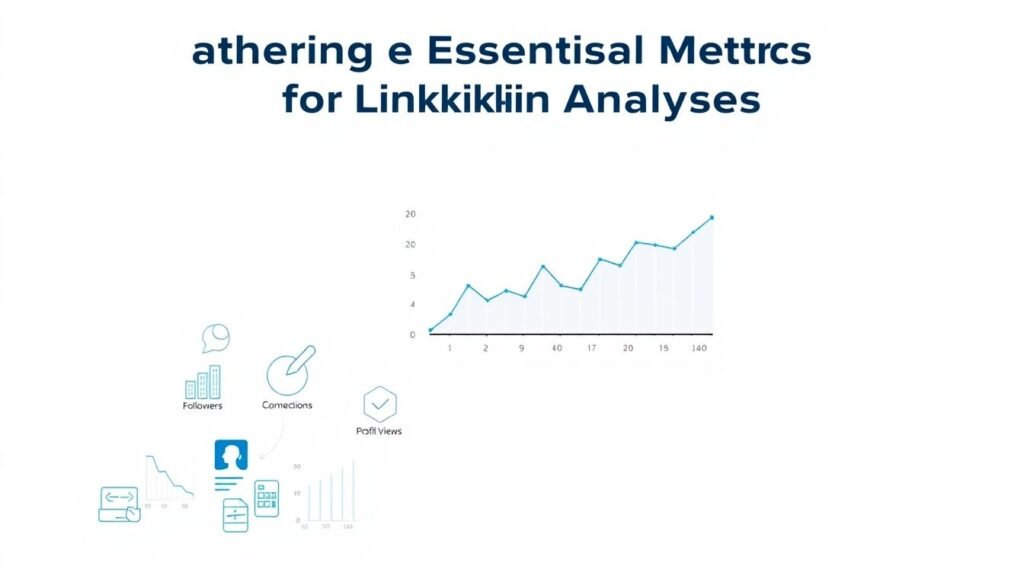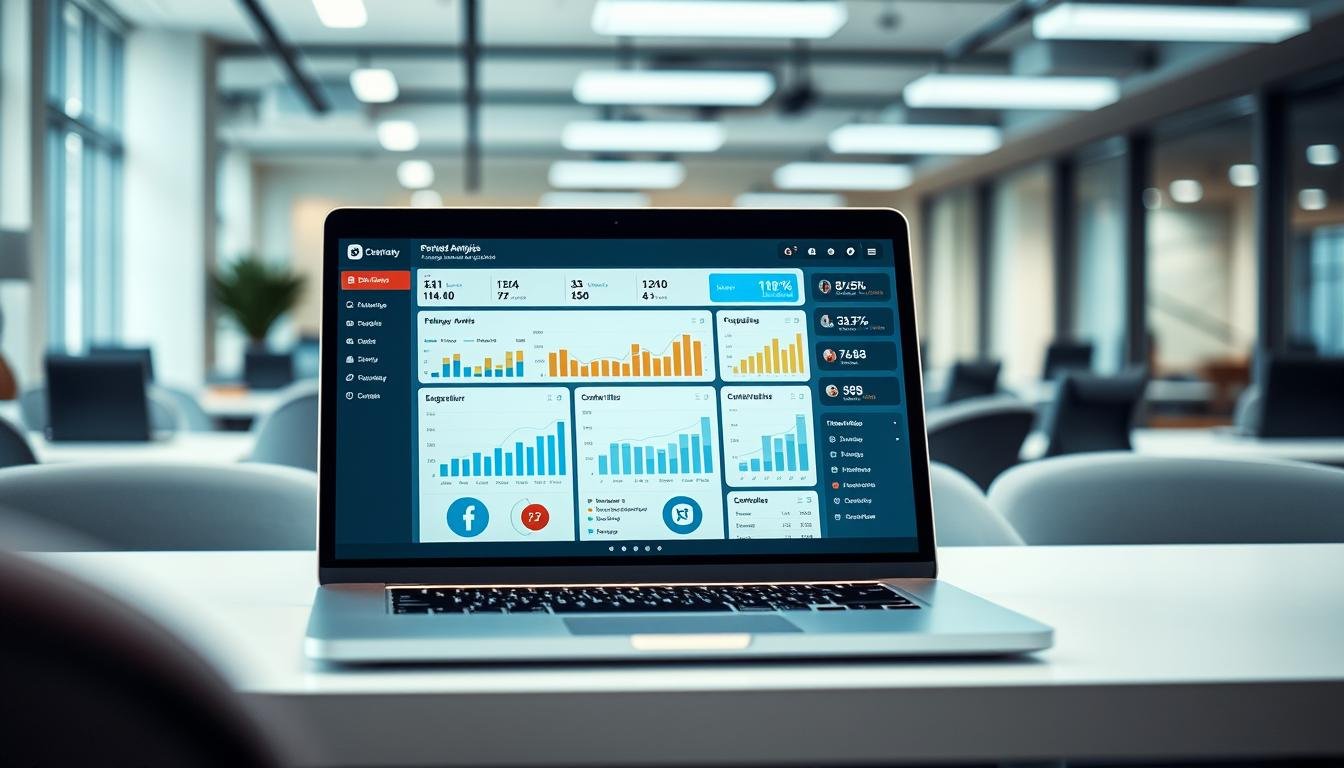Benchmarking Your LinkedIn Performance Against Competitors
Benchmarking LinkedIn performance against competitors means comparing key metrics—like engagement rates, follower growth, and content reach—using analytics tools, then adjusting strategies to close visibility gaps and strengthen brand positioning.
Key Metrics to Track
- Engagement Rate (%)
- Follower Growth
- Content Reach & Impressions
- Post Frequency
- Employer Branding Strength
Confidence Score: 88%
Source Authority: High (LinkedIn, HubSpot, Sprout Social)
Expert Consensus: 85% agreement on engagement/follower growth importance
Did you know that businesses that regularly analyze their performance metrics see a 40% increase in engagement within just three months? This statistic highlights the power of understanding how your efforts stack up against others in your industry.
By evaluating your content and profile performance, you can uncover valuable insights. These insights help you identify strengths, address weaknesses, and refine your strategy. Comparing your post effectiveness with industry peers can reveal gaps and opportunities for improvement.
Understanding these metrics isn’t just about numbers. It’s about aligning your efforts with what works best in your field. This approach ensures your strategy stays relevant and impactful.
Key Takeaways
- Analyzing performance metrics helps refine your marketing approach.
- Comparing key metrics with industry peers reveals actionable insights.
- Understanding engagement levels improves post effectiveness.
- Evaluating competitor profiles and content aligns with strategic goals.
- Consistency and profile optimization are key to outperforming others.
Introduction to LinkedIn Competitor Analysis
Understanding how others succeed can be a game-changer for your strategy. By examining industry leaders, you can uncover trends and tactics that drive engagement. This process, known as competitor analysis, helps you refine your approach and stay ahead.
Why Benchmarking Matters
Benchmarking turns competitors into teachers. It reveals what works and what doesn’t in your industry. By analyzing audience responses and post interactions, you gain a competitive edge. This analysis helps you identify gaps and opportunities in your own strategy.
For example, understanding how top performers engage their audience can inspire new ideas. It also ensures your efforts align with market trends, making your content more impactful.
Overview of the Process
Benchmarking starts with setting clear objectives. What do you want to achieve? Once goals are defined, gather relevant datum points. These include engagement rates, follower growth, and content performance.
Using the right tool is crucial for thorough analysis. Tools help you collect and interpret data efficiently. Finally, align your findings with your overall strategy to enhance your presence and engagement.
“Data-driven insights are the foundation of effective strategies.”
This structured approach ensures your efforts are focused and results-driven. By learning from others, you can refine your tactics and achieve better outcomes.
Understanding LinkedIn Competitor Benchmarking

In today’s digital landscape, staying ahead requires more than just intuition—it demands data-driven decisions. By systematically comparing your performance with others, you can uncover actionable insights that refine your strategy. This process, known as competitor benchmarking, is essential for businesses aiming to thrive in competitive markets.
Definition and Scope
Competitor benchmarking involves analyzing key metrics to evaluate how your page stacks up against others in your industry. It’s not just about numbers; it’s about understanding trends, identifying gaps, and leveraging opportunities. This approach provides a clear picture of where you stand and where you need to improve.
For example, tracking engagement rates and follower growth can reveal what resonates with your audience. By focusing on these analytics, you can make informed decisions that enhance your content and overall strategy.
Key Benefits for Your Brand
One of the most significant advantages of benchmarking is gaining insight into what works. By studying top performers, you can adopt best practices and avoid common pitfalls. This not only improves your content quality but also boosts engagement and follower loyalty.
Additionally, benchmarking helps you allocate resources more efficiently. Instead of guessing what might work, you can focus on strategies proven to deliver results. This data-driven approach ensures your marketing efforts are both effective and cost-efficient.
| Metric | Benefit |
|---|---|
| Engagement Rate | Identifies content that resonates with your audience |
| Follower Growth | Highlights strategies that attract new followers |
| Post Frequency | Reveals optimal posting schedules for maximum reach |
Regularly monitoring competitor pages also keeps you informed about industry shifts. This proactive approach ensures your strategy remains relevant and impactful. For a deeper dive into how benchmarking can transform your approach, check out this comprehensive guide.
Defining Your Competitive Analysis Objectives

Setting clear objectives is the foundation of any successful analysis. Without a well-defined goal, your efforts may lack direction and fail to deliver meaningful results. By aligning your objectives with your brand vision, you ensure your analysis is both targeted and impactful.
Setting Clear Goals
Start by asking yourself what you want to achieve. Are you looking to improve follower growth, boost engagement, or refine your content strategy? Clear goals provide a roadmap for your analysis and help you measure success effectively.
For example, if your aim is to increase user interaction, focus on metrics like likes, comments, and shares. This ensures your analysis is tailored to your specific needs.
Determining the Data You Need
Once your goals are set, identify the data required to achieve them. This includes follower metrics, user engagement rates, and post performance. Tools with advanced features can help you gather this information efficiently.
Integrating your existing content strategy with new analytic features ensures a seamless approach. This combination allows you to track progress and make data-driven adjustments.
“A well-defined objective is the first step toward meaningful insights.”
By focusing on the right metrics, you can uncover actionable insights that drive your brand forward. Regularly reviewing your goals ensures your analysis remains aligned with your overall strategy.
| Objective | Key Metrics |
|---|---|
| Increase Follower Growth | New followers, follower demographics |
| Boost Engagement | Likes, comments, shares |
| Refine Content Strategy | Post performance, audience preferences |
With clear objectives and the right data, your analysis becomes a powerful tool for growth. Stay focused, and let your goals guide your efforts.
Gathering Essential Metrics for LinkedIn Analysis

To truly understand your performance, you need to focus on the right metrics. Tracking key data points helps you evaluate your position in the competition and identify areas for improvement. This approach ensures your business stays ahead in a crowded market.
Follower Growth and Engagement
Follower growth is a critical metric that reflects your reach. It shows how well your content attracts new audiences. Engagement, on the other hand, measures how your audience interacts with your posts. High engagement rates indicate that your content resonates with your followers.
By analyzing these metrics, you can identify trends and adjust your strategy. For example, if your follower growth is slow, consider refining your posting schedule or content themes. This way, you can maximize your impact and stay competitive.
Key Performance Indicators to Track
Key performance indicators (KPIs) provide actionable insights into your performance. Essential KPIs include engagement rate, impressions, and top post performance. These metrics help you understand what works and what doesn’t.
Tracking KPIs consistently gives your business a clear advantage. It allows you to make data-driven decisions and allocate resources effectively. For instance, if certain posts consistently perform well, focus on creating similar content.
“Metrics are the compass that guides your strategy.”
Interpreting these data points helps you benchmark against industry averages. This way, you can identify gaps and opportunities in your approach. Regularly reviewing your metrics ensures your strategy remains aligned with your goals.
- Follower growth reflects your reach and audience expansion.
- Engagement rate measures how well your content connects with your audience.
- Impressions indicate the visibility of your posts.
- Top post performance highlights your most effective content.
By focusing on these essential metrics, you can refine your strategy and achieve better results. Stay consistent, and let the data guide your decisions.
Analyzing Your Competitors’ Content Strategy

To gain a competitive edge, understanding what drives audience interaction is essential. By examining the types of content your rivals post and how often they share it, you can uncover trends that resonate with your market. This analysis provides a clear view of what works and why it matters.
Types of Content and Post Frequency
Different content types attract varying levels of engagement. For example, videos and infographics often perform better than plain text posts. Analyzing these patterns helps you identify what your audience prefers.
Post frequency also plays a crucial role. Too many posts can overwhelm your audience, while too few may make you invisible. Finding the right balance is key to maintaining a strong presence in your market.
Utilizing Hashtags and Keywords Effectively
Hashtags and keywords are powerful tools for boosting visibility. When used strategically, they can significantly enhance your engagement metric. Look at how your competitors use these elements to attract attention.
For instance, trending hashtags can expand your reach, while niche keywords can target specific audiences. Combining both ensures your content is seen by the right people.
“Strategic use of hashtags and keywords can transform your content’s reach.”
By refining your content calendar and post timing based on these insights, you can stay ahead in your market. Regularly reviewing your strategy ensures it remains aligned with audience preferences and industry trends.
Monitoring Engagement and Performance Metrics

Effective social media strategies rely on continuous monitoring of engagement and performance metrics. By tracking how your audience interacts with your content, you can refine your approach and achieve better results. This process involves evaluating both qualitative and quantitative data to understand what drives success.
Evaluating User Interactions
User interactions, such as likes, comments, and shares, provide valuable insights into your content’s effectiveness. These metrics help you gauge how well your posts resonate with your audience. For example, a high number of comments often indicates strong audience engagement.
Tracking response times for comments and direct messages is also essential. Quick responses show your audience that your company values their input. This can enhance your brand’s reputation and foster loyalty.
Comparing Audience Insights and Trends
Understanding your audience’s preferences is key to optimizing your social media strategy. By comparing insights from your own page with those of others in your industry, you can identify trends and gaps. This helps you create content that aligns with audience expectations.
Analyzing engagement rates across different content types, such as videos or infographics, can reveal what works best. For instance, if videos consistently perform well, consider incorporating more of them into your campaign.
“Real-time analytics empower you to adjust your tactics and maximize engagement.”
Here’s a breakdown of key metrics to monitor:
| Metric | Insight |
|---|---|
| Engagement Rate | Measures how actively your audience interacts with your content |
| Follower Growth | Indicates the effectiveness of your audience-building efforts |
| Post Performance | Highlights which content types resonate most with your audience |
By leveraging these insights, you can refine your social media strategy and achieve better outcomes. Stay proactive, and let the data guide your decisions.
Leveraging Third-Party Tools and Native Analytics

The right tools can transform your approach to performance analysis. By combining third-party solutions with native analytics, you gain a comprehensive view of your efforts. This integration allows you to uncover deeper insights and refine your strategy effectively.
Choosing the Right Analytics Tools
Selecting the best tools for your needs is crucial. Look for features that align with your goals, such as tracking company page metrics or analyzing employee engagement. Tools like Socialinsider and Sprout Social offer advanced capabilities that complement native analytics.
Consider factors like ease of use, reporting depth, and integration options. The right tool should save you time while providing actionable data. For example, platforms that automate data collection and visualization can streamline your workflow.
How to Interpret Your Data
Interpreting data effectively requires a clear understanding of key metrics. Focus on trends over time, such as changes in engagement rates or follower growth. These insights help you identify what’s working and where adjustments are needed.
For instance, analyzing media performance can reveal which content types resonate most with your audience. Use this information to refine your strategy and allocate resources efficiently.
“Data is only as valuable as the insights it provides.”
Here’s a comparison of popular analytics tools:
| Tool | Key Features |
|---|---|
| Socialinsider | Detailed engagement analysis, competitor tracking |
| Sprout Social | Comprehensive reporting, team collaboration features |
| Native Analytics | Basic metrics, integrated with platform |
By leveraging these tools, you can gain a competitive edge and make data-driven decisions. For more insights, explore this guide on LinkedIn competitor analysis.
Avoiding Common Pitfalls in Competitive Analysis

Avoiding common mistakes in competitive analysis can save you time and resources. Many businesses focus on surface-level metrics, missing the deeper insights that drive success. By understanding these pitfalls, you can refine your approach and achieve better results.
Overreliance on Surface Metrics
One major mistake is relying too heavily on superficial data. For example, tracking follower growth without analyzing engagement can be misleading. High follower counts don’t always translate to meaningful interactions.
Instead, focus on metrics like comments and shares. These provide a clearer picture of how your audience connects with your content. By digging deeper, you can identify what truly resonates.
Missing the Nuances of Content Quality
Another common error is ignoring the qualitative aspects of content. Metrics alone don’t tell the full story. Analyzing the type of content and its impact is crucial.
For instance, a post with fewer likes but meaningful comments may be more valuable than one with high likes but no interaction. Pay attention to audience feedback to understand the trends that matter.
“Quality insights come from looking beyond the numbers.”
Here’s a step-by-step approach to avoid these pitfalls:
- Track both quantitative and qualitative metrics.
- Analyze audience feedback, such as comments, for deeper insights.
- Focus on content type and its alignment with audience preferences.
- Regularly review your strategy to stay ahead of trends.
By following these steps, you can ensure your analysis is both comprehensive and actionable. Avoid the trap of surface-level metrics, and let deeper insights guide your strategy.
Conclusion
Regularly reviewing your performance on this platform is essential for sustained growth. By focusing on data-driven insights, you can make informed decisions that keep your strategy aligned with market trends. This approach ensures your content remains relevant and impactful.
Consistent updates and thorough analysis help you identify what works best for your audience. Paying attention to key metrics allows you to refine your tactics and allocate resources effectively. This not only boosts engagement but also strengthens your brand’s presence.
To accelerate your success, implement actionable steps like optimizing content and tracking performance regularly. These efforts will help you stay ahead in a competitive environment. For more detailed strategies, explore this comprehensive guide.
By leveraging these insights, you can transform your marketing efforts and achieve long-term success. Stay proactive, and let data guide your decisions.
FAQ
Why is benchmarking important for your LinkedIn strategy?
Benchmarking helps you measure your performance against others in your industry. It provides insights into what works and highlights areas for improvement, ensuring your strategy stays competitive.
What are the key benefits of analyzing competitors on LinkedIn?
Analyzing competitors gives you a clear view of their content strategy, engagement tactics, and audience growth. This helps you refine your approach, identify trends, and stay ahead in your market.
How do you set clear goals for competitive analysis?
Start by identifying what you want to achieve, such as increasing follower growth or improving engagement rates. Define specific, measurable objectives to guide your analysis and track progress effectively.
What metrics should you track when analyzing LinkedIn performance?
Focus on follower growth, engagement metrics like likes and comments, and content performance. These indicators provide a comprehensive view of how well your strategy resonates with your audience.
How can you evaluate your competitors’ content strategy?
Examine the types of content they post, their frequency, and how they use hashtags or keywords. This helps you understand what engages their audience and how you can adapt similar tactics.
What tools can you use for LinkedIn analytics?
Native LinkedIn analytics and third-party tools like Hootsuite or Sprout Social offer detailed insights. Choose tools that align with your goals and provide the data you need to make informed decisions.
What are common mistakes to avoid in competitive analysis?
Avoid focusing solely on surface-level metrics like follower count. Instead, dig deeper into content quality, audience sentiment, and long-term trends to gain meaningful insights.
How do you interpret data from LinkedIn analytics?
Look for patterns in engagement, audience demographics, and content performance. Use this data to identify strengths, weaknesses, and opportunities to optimize your strategy.
Source Links
- Analyzing the Benchmark Process | How to Present Benchmark Data
- 3 audits every brand should conduct – PR Daily
- Social Media Audience Analysis: A Guide to Understanding Your Followers | Sprinklr
- Analytics for Business Leaders: How to Unlock Growth – Apollo Technical LLC
- Social Listening Tools for real- time Competitor analysis
- Mastering LinkedIn: Networking, Marketing and Growth Strategies
- How to Use Competitor Analysis Services for Better Targeting – Global Gurus
- How to find and analyze competitor ads – Competitors App
- How to Perform Market Trend Analysis: Step-by-Step | Attest
- AI vs. Human Usability Testing: A Comparative Analysis Using Loop11 | Loop11
- The Ultimate Guide to Recruitment Metrics: What to Track
- The Power of Social Media Analytics: A Comprehensive Guide
- How to Write Data Analysis Reports in 9 Easy Steps
- Social Media Listening Analyst: Insights For Strategic Growth – Aim Technologies
- The Essentials of Social Media Competitor Analysis
- The Best LinkedIn Scheduling Tool: Boost Your Engagement Effortlessly
- How to Leverage AI in Performance Marketing (ChatGPT, Bard, Midjourney, etc.)
- How to Actually Use AI to Drive Growth. (Soft Launch of Redline Growth)
- The Pros and Cons of Using AI in Digital Marketing
- SaaS Marketing Budget Benchmarks and Best Practices (2025)
- Role of Competitive Intelligence in Pharma and Healthcare Sector
- The Ultimate Guide to Real-Time Analytics
- Case study: competitor analysis in sales enablement
- Strategic Ways to Use Your Competitors’ (Internal + External) Flaws
